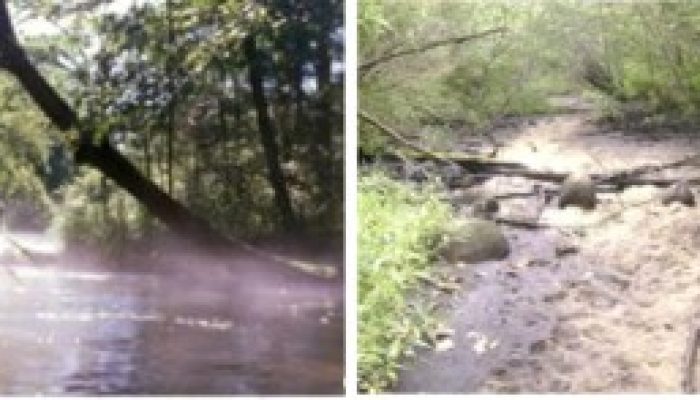
By Sam Zipper, postdoctoral fellow at Madison and author of tacosmog.com
We often think of groundwater as a nonrenewable reservoir, deep underground, and with good reason – less than ~6% of groundwater globally entered the ground within the past 50 years. However, where a river or stream intersects the water table, water is able to move from the aquifer to the stream (or vice versa). This supply of shallow groundwater to streams is called ‘baseflow’, and is an important supply of water for many streams worldwide, especially during dry seasons or periods of drought. Below, we can see that baseflow makes up more than 50% of total streamflow over most of the world:
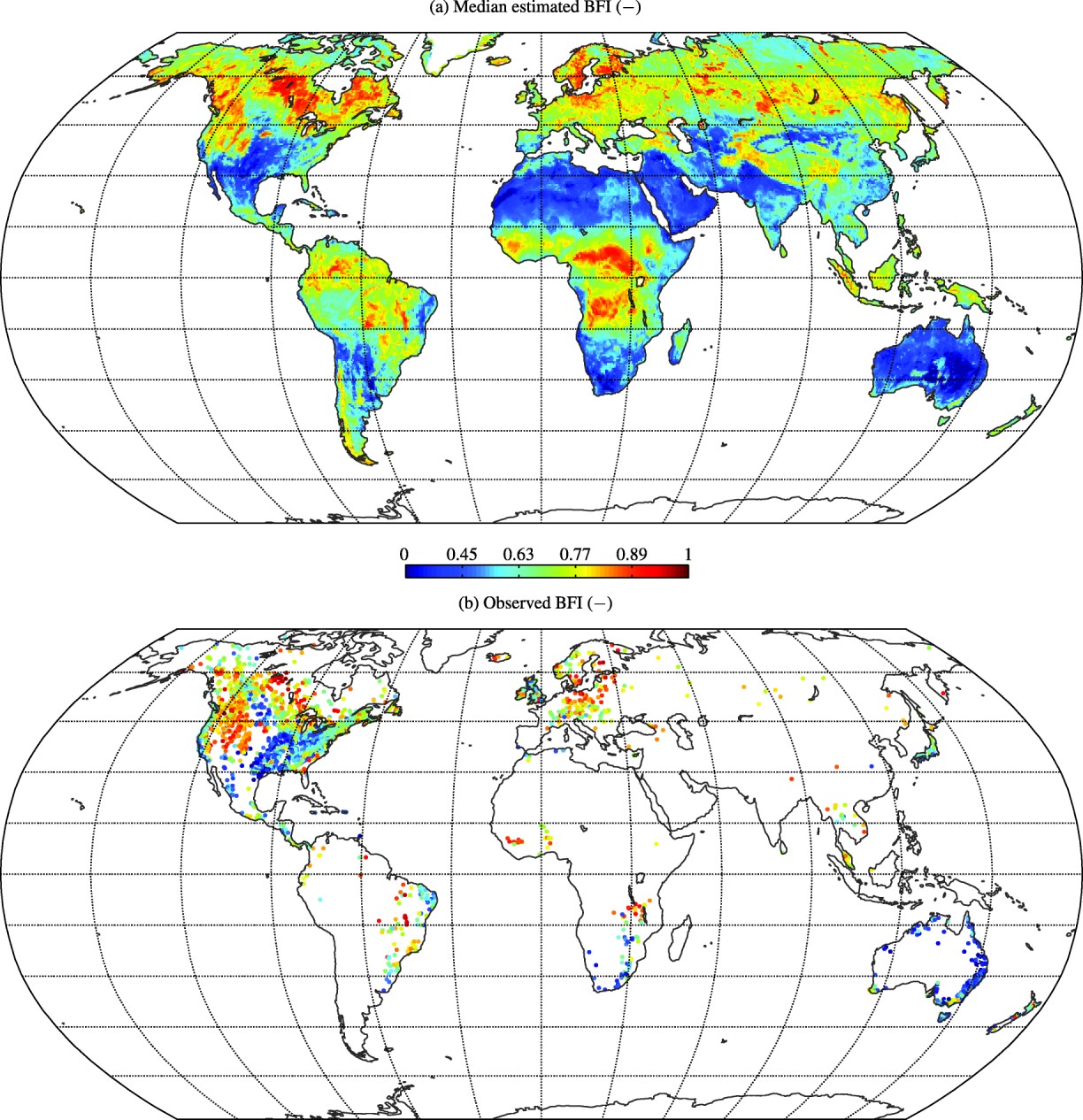
Global estimates of baseflow index – the proportion of streamflow that comes from groundwater or other slowly varying sources, like upstream lakes and wetlands.
The ability of groundwater to contribute to streamflow depends on the water level of the aquifer in the area surrounding the stream. Therefore, human actions that lower groundwater levels (such as pumping for urban or agricultural use) can impair the ability of an aquifer to supply water to streams during dry periods, with potentially devastating consequences for streamflow.
One example close to my home is the Central Sands region of Wisconsin, which is a large region found (not surprisingly) in the center of the state with particularly sandy soils. The sandy soils are perfect for growing potatoes, and the Central Sands is primarily an agricultural region; however, because water drains quickly from sandy soils, irrigation has become an increasingly important part of the landscape:
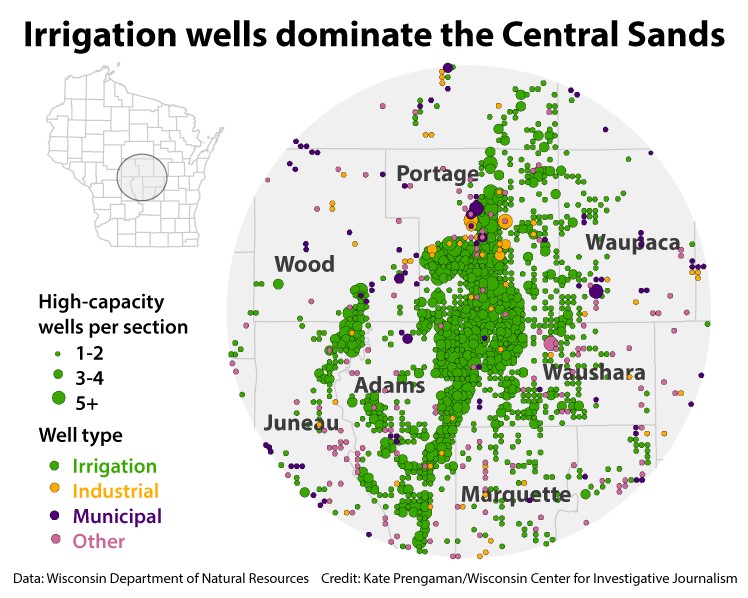
In addition to agriculture, however, the Central Sands region is home to many rivers, lakes, and streams. Recently, one river in particular has become a microcosm of the debate surrounding the impacts and trade-offs of agricultural water use: the Little Plover River. While only 6 miles long, the Little Plover is a prized brook trout fishery and important ecosystem within the region. According to American Rivers, which listed the Little Plover as one of America’s 10 most endangered rivers in 2013, streamflow in the Little Plover has been decreasing since the 1970s and flows today are roughly half of the historical normal. The situation in the Little Plover came to a head in 2005, when several stretches of the Little Plover dried up, with predictably negative consequences for the fish.
Over the past decade, the Little Plover has been mired in legal controversy. In 2009, the Wisconsin Department of Natural Resources established what they call a “Public Rights Flow”, or a required amount of streamflow that the public is entitled to flow through the river. The advocacy leading to the establishment of this Public Rights Flow was primarily by conservation groups like the River Alliance and Trout Unlimited, with the goal of protecting fish and the rest of the stream ecosystems. In order to set the threshold, the Wisconsin Department of Natural Resources first established a baseline level as the 7-day average low flow with a 10% probability of occurring in a given year, and then adjusted this value upwards based on estimates of the flow necessary for to provide fish habitat and recruit trout. Despite the positive step of establishing a Public Rights Flow, measurements during the 2012 drought were consistently below the thresholds set by the Department of Natural Resources, and the Little Plover even dropped below the thresholds in 2013 and 2014, both of which were relatively wet years for Wisconsin.
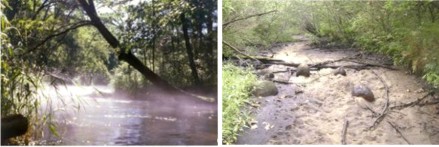
The Little Plover in 1997 and the first time in ran dry in 2005 (Friends of the Little Plover)
The current debate surrounding the Little Plover hinges on whether the Department of Natural Resources is legally allowed to consider cumulative impacts when permitting new high capacity wells in the region. Previously, the Department of Natural Resources was not considering cumulative impacts, which means that for every well application, they are only allowed to think about that well in isolation – and the effects of a single well are typically small enough that the Department of Natural Resources does not have sufficient grounds to deny a permit. However, the relatively small impacts of many individual wells can add up to cause a big overall effects on local groundwater resources. This changed in 2014, when a judge ruled that the Department of Natural Resources should be considering cumulative impacts. The effects of this ruling remain to be seen, but it improves the DNR’s ability to manage groundwater and surface water resources while considering the interactions between the two.
Thus, the Little Plover River provides a powerful example of a case where a little bit of groundwater drawdown can lead to big environmental, political, and economic issues. Currently, hydrogeologists at the Wisconsin Geological Natural History Survey and USGS Wisconsin Water Science Center are working on developing a groundwater flow model of the region to help understand the impacts of groundwater withdrawals on the aquifer, and what that means for local surface water features like streams and lakes. Because the waters of the Central Sands are valued for many different uses, including farming, urban supply, and outdoor recreation, the team building this model has been working closely with different groups of users to determine the priorities and needs of the various water users the region, and make sure that their scientific tool they develop is both useful to and trusted by the decision-makers in the region. As the future of the Little Plover and other rivers unfold under increasing human pressures and climate change, it is critical that water scientists work together with the public to conduct fair and unbiased science that provides timely and useful information for the decision-making process.

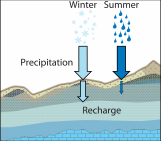


Pingback: The great American groundwater road trip: Interstate 80 over the Ogallala Aquifer | Water Underground